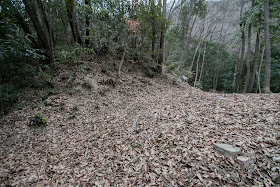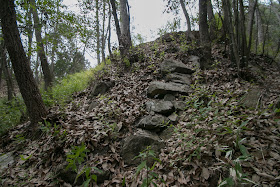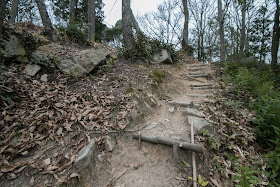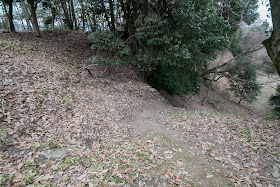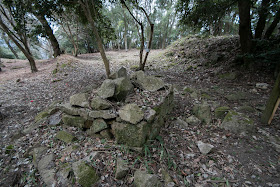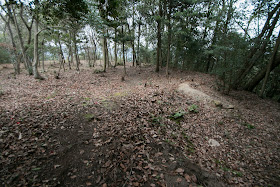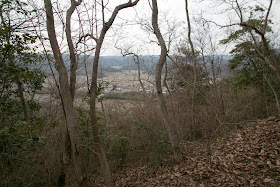Niitakayama Castle
-Intellectual pillar of Mouri clan (2)-
Overview
Name: Niitakayama castle (Niitakayama-jo)
Alias:
Place: Hongo-cho Mihara city, Hiroshima
Location: 34.42034848469213, 132.97355779815604
Type: Mountain Castle
Built: 1552
Remaining remnants: Stone walls and clay walls
Title:
Continued from Part 1
Niitakayama castle (新高山城) is located over the hilltop of Niitakayama mountain, one of about 200 meter height beside Nutagawa River. Currently castle site is over five kilometer apart from Setonaikai sea, but formerly a long embayment continued from Mihara area to castle site. At this point Niitakayama mountain and Takayama mountain soar at the both side of Nutagawa river like natural gate.
Actually Nutagawa river runs east and westward was used as a route of Sanyodo road which is a main route connected Hiroshima area and Fukuyama area, and castle site is an important point which connected Sanyodo road, Setonaikai sea and inland mountainous area
Precise year is unknown but Niitakayama castle was originally built by Kobayakawa clan in 15th century as a branch castle of their first residence Takayama castle (Hiroshima prefecture), which located at the top of Takayama mountain at the opposite side of Nutagawa river. Kobayakawa clan is said as a descendant of Sanehira Dohi (?-1191), a local retainer of Sagami province (Kanagawa prefecture) who supported raise of Yoritomo Minamoto (1147-1199), the founder of Kamakura Shogunate, from first stage.
Dohi clan achieved Numata providence as a reward for their contribution, but during the continuous political conflict Dohi clan lost their position at the Shogunate, thus they moved to their territory Numata area and renamed to Kobayakawa clan. Furthermore, Kobayakawa clan activated at the battle of Jokyu between Imperial Household supporters and Kamakura Shogunate occurred in 1221, and got current Takehara area at the next of Numata area.
Kobayakawa clan built branch family at Takehara area and they were called as Takehara Kobayakawa clan, compared with main family named as Numata Kobayakawa clan. It is said that Numata Kobayakawa clan built Takayama castle as their residence in 1206, and Takehara Kobayakawa clan also constructed Kimura castle as their main base.
In 14th century and 15th century, Kobayakawa clan gradually grew their power in cooperation with Numata Kobayakawa clan and Takehara Kobayakawa clan. The governor of Bingo province (eastern part of Hiroshima prefecture) was Yamana clan which was one of the highest retainer of Muromachi Shogunate, but significantly lost their power after the battle of Onin in which they fought as a leader of western army.
Originally Kobayakawa clan made many branch families and spread into north part of Geiyo Island, a group of island spreads over Setonaikai sea between current Hiroshima prefecture and Ehime prefecture. Utilizing the down fall of Yamana clan, Kobayakawa clan expelled Yamana clan from Mihara area and united their branch family as Kobayakawa navy. They engaged in production and distribution of salt, and also marine transportation of the area in cooperation with Murakami navy.
As above Kobayakawa clan grew into a major local lord of Bingo province, but was also affected by surrounding strong warlords such as Ouchi clan which was the governor of Suo province and Nagato province (Yamaguchi prefecture), or Amago clan which was the warlord of Izumo province (Shimane prefecture). To cope with these external powers, local lords of Aki province (western part of Hiroshima prefecture) and Bingo province made alliance at the beginning of 16th century, and their leader was Mouri clan which was the lord of Aki Koriyama castle (Hiroshima prefecture).
But in the former half of 16th century, the conflict between Ouchi clan and Amago clan became fierce and Kobayakawa clan was inevitably involved in this situation. Furthermore, both of Numata Kobayakawa clan and Takehara Kobayakawa clan lost their leader without successor under this situation, then retainers of Kobayakawa clan asked Mouri clan to send the successor to Kobayakawa clan. Responding to this request, Takakage Kobayakawa (1533-1598), the third son of Motonari Mouri (1497-1571), was sent to Kobayakawa clan and became their leader.
In 1551, the battle of Itsukushima between Motonari and Harukata Sue (1521-1555), a vassal of Ouchi clan but overthrown the clan by coup d’?tat occurred. Facing dominant Sue army, Motonari lead Harukata to narrow Itsukushima island by trick and made a sudden attack by sea and land. Takakage participated in this battle leading Murakami navy, and frightened Sue army were caused a severe conflict and Harukata died in the island. By this battle, Mouri clan took a step toward the ruler of Chugoku region replacing Ouchi clan.
During next 20 years, Mouri clan ruined Amago clan and became the ruler of Chugoku region. Takakage took charge of Sanyo area, and along with Motoharu Kikkawa (1530-1586), elder brother of Takakage who managed Sanin region from Hinoyama castle (Hiroshima prefecture), contributed to the growth of Mouri clan. Takakage supported Naoie Ukita (1529-1582), a warlord of Bizen province (Okayama prefecture) upraised from small local retainer, and ruined other warlords such as Mimura clan or Uragami clan.
After the death of Motonari, as his eldest son Takamoto Mouri (1523-1563) died in youth, thus Terumoto Mouri (1553-1625), son of Takamoto, succeeded the leader position. Motoharu and Takakage continuously supported Terumoto and this situation is said as the structure of Mouri double “river”, as Motoharu and Takakage both include the character means river in their sir names.
Opposite to Motoharu known as a brave general and was a military pillar of Mouri clan, Takakage had a talent of intelligence and acted as an intellectual pillar. Takakage also engaged in the maritime commerce at Setonaikai sea and economically supported Mouri clan. Along with the increase of his power, Takakage significantly expanded Niitakayama castle and changed his main base from Takayama castle in 1552, and continued construction after that.
The shape of Niitakayama castle looks like two blade tabletop fan. The main body of the castle is a straightly continued line of areas from east to west, including inner area, central area, Nakamomaru area, Ishiyumi area, Nishinomaru area and Kitanomaru area along with the ridge. Central area of the castle is a rectangular area of 100 meter long and 40 meter wide, which had a ruin of magnificent stone wall at its western edge.
At the north of central area, between two terraces named Higashinomaru and Nishinomaru spread toward north, there is a large terrace named as “Tsurii no Dan” area has several wells. This part has large and well-shaped terraces the might be expanded later. Compared to this, western part of hilltop area keeps old style divided into small terraces keep the shape of original terrain.
At the below of hilltop area, there is a terrace used as a ground of ruin of Kyoshinji temple. This part worked an entrance to hilltop area, and climbing road to this area was protected by three layered guarding points built by digging ridge and equipped tall stone wall. At the opposite of these guarding points, there was a front fort named as Kaneno-dan built at small peak.
Total size of the castle is about 500 meter long square, and plan of the castle which shove several ridges and continuously placed terraces separated by stone walls quite resembles to Tachibanayama castle (Fukuoka prefecture) which was later renovated into modern castle by Takakage.
The power of Mouri clan once reached to Harima province (Hyogo prefecture) at the western end of Kinki region, but Mouri clan had to face central ruler Nobunaga Oda (1534-1582). At first Mouri clan rejected the pressure of Nobunaga, but Nobunaga appointed Hideyoshi Hashiba (1537-1598, later Hideyoshi Toyotomi) as a regional commander of Chugoku region and ordered to attack Mouri clan.
Among tough situation Hideyoshi fell Miki castle of Harima province which belonged to Mouri clan after two year siege, expanded into Tajima province (north part of Hyogo prefecture) then let Naoie Ukita to turn to Oda clan. Furthermore, in 1581, Hideyoshi captured secure Tottori castle (Tottori prefecture) by cutting its supply.
Now Hideyoshi had the same army as Mouri clan and he did not need to care his backward protected by his master. On the other hand, Mouri clan was gradually lost its territory and also took care of another front at its backside. Facing this situation, Motoharu insisted through resistance to Hideyoshi, but Takakage looked for peace with Oda army (probably to keep the motivation of the clan they intended to do so).
In 1582, Hideyoshi marched to Bicchu province (western part of Okayama prefecture) and sieged Bicchu Takamatsu castle by flood attack. Terumoto, Motoharu and Takakage sallied as a reinforcement to the castle, but they could not do any measure. Nobunaga planned to send his main army to this front to make the decisive battle, and Mouri clan was pushed to the corner.
But in the halfway , Nobunaga was assassinated by his general Mitsuhide Akechi (1528-1582) at the incident of Honnoji, and knowing this news Hideyoshi decided to make peace with Mouri clan concealing the death of Nobunaga, then turned whole army to Kinki region to make revenge of his master.
Considering inferior situation and Nobunaga’s reinforcement, Takakage decided to make peace with Hideyoshi by ceding several provinces. Just after the agreement the news of the death of Nobunaga came to Mouri clan, but Takakage did not break the deal in spite of the opposition of Motoharu and did not attack retreating Hashiba army from backside.
As expected Hideyoshi broke Mitsuhide Akechi at the battle of Yamazaki then became the successor of Nobunaga. Mouri clan decided to continue a large lord under Toyotomi government, considering the ability of Terumoto. Mouri clan kept neutral for the internal conflict between former generals of Oda clan, and this supported Hideyoshi to seize the next hegemony.
Hideyoshi also needed support from large merchants of Osaka and Kyoto area, and they needed security of marine transportation at Setonaikai sea connected Hakata port and Osaka port. From this view point Takakage who managed Kobayakawa navy was important to Hideyoshi, then Hideyoshi thought Takakage as a commander of Setonaikai sea. Hideyoshi appointed Takakage as a lord of Iyo province (Ehime prefecture) after Shikoku campaign, and also the magistrate of Hakata city after Kyushu campaign.
Because of above reasons, Takakage was deeply trusted by Hideyoshi, and also by his military staff Yoshitaka Kuroda (1546-1604, famous as Kanbe). Hideyoshi was said to mention that people have intelligence, courage and ambition can be the ruler, and Takakage has both intelligence and ambition (but lacked courage). Even though still a retainer of Mouri clan, Takakage also directly served to Hideyoshi.
Takakage said to Yoshitaka that “you are too wise and decide things promptly, then you might regret later. I am not talented as you and think carefully, thus I do not regret things”. On the other hand, when Takakage died, Kanbe mourned that “we lost the wise man of the world”.
In 1582, after the reconciliation with Hideyoshi, Takakage newly built Mihara castle (Hiroshima prefecture) just next to Setonaikai sea, to grasp the islands and marine transportation of Setonaikai area. Furthermore, in 1595, Takakage decided to retire and further renovated Mihara castle as his retirement place, thus broke the stone wall of Niitakayama castle and brought them to Mihara castle.
Takakage was still the one of the five grand minister of Toyotomi government, and also a highest retainer of Mouri clan. But Takakage died in 1597 in ill, and Niitakayama castle was totally disposed after the loss of Bingo province for Mouri clan as a result of the battle of Sekigahara in 1600.
Now all building was lost and major part of stone wall was also broken. It is said that main gate of central area was transferred to the temple at Mihara city but unclear if it is true or not. But large stones slightly remains around central area or Kyoshinji temple shows past magnificent shape of the castle.
Compared with Hinoyama castle, the main base of Motoharu Kikkawa, Mihara castle seems less steep and more open. This reflects the character of Takakage and Motoharu, and also the method of both general to increase the power of Mouri clan, it mean merchandise at Sanyo region and military power at Sanin region. However, climbing road to castle is steep and slippy, thus visitors need care to walk around.
15 minutes walk from JR West Sanyo-Honsen line Hongo station. 15 minutes drive from Sanyo-Jidoshado Expressway Hongo interchange. 30 minutes walk from hillside entrance to hilltop castle.
Mihara Castle -Naval base castle at Inland Sea-
Aki Koriyama Castle -Proverb of three arrows-
Hinoyama Castle -Military pillar of Mouri clan-
Tachibanayama Castle -Brave general regarded as incarnation of thunder-
Takayama Castle (Aki) -Intellectual pillar of Mouri clan (1) take over and restructuring-
Type: Mountain Castle
Built: 1552
Remaining remnants: Stone walls and clay walls
Title:
Brief History
Continued from Part 1
Niitakayama castle (新高山城) is located over the hilltop of Niitakayama mountain, one of about 200 meter height beside Nutagawa River. Currently castle site is over five kilometer apart from Setonaikai sea, but formerly a long embayment continued from Mihara area to castle site. At this point Niitakayama mountain and Takayama mountain soar at the both side of Nutagawa river like natural gate.
Actually Nutagawa river runs east and westward was used as a route of Sanyodo road which is a main route connected Hiroshima area and Fukuyama area, and castle site is an important point which connected Sanyodo road, Setonaikai sea and inland mountainous area
Settle down of Kobayakawa clan
Precise year is unknown but Niitakayama castle was originally built by Kobayakawa clan in 15th century as a branch castle of their first residence Takayama castle (Hiroshima prefecture), which located at the top of Takayama mountain at the opposite side of Nutagawa river. Kobayakawa clan is said as a descendant of Sanehira Dohi (?-1191), a local retainer of Sagami province (Kanagawa prefecture) who supported raise of Yoritomo Minamoto (1147-1199), the founder of Kamakura Shogunate, from first stage.
Dohi clan achieved Numata providence as a reward for their contribution, but during the continuous political conflict Dohi clan lost their position at the Shogunate, thus they moved to their territory Numata area and renamed to Kobayakawa clan. Furthermore, Kobayakawa clan activated at the battle of Jokyu between Imperial Household supporters and Kamakura Shogunate occurred in 1221, and got current Takehara area at the next of Numata area.
Kobayakawa clan built branch family at Takehara area and they were called as Takehara Kobayakawa clan, compared with main family named as Numata Kobayakawa clan. It is said that Numata Kobayakawa clan built Takayama castle as their residence in 1206, and Takehara Kobayakawa clan also constructed Kimura castle as their main base.
Grow into major local lord of Bingo province
In 14th century and 15th century, Kobayakawa clan gradually grew their power in cooperation with Numata Kobayakawa clan and Takehara Kobayakawa clan. The governor of Bingo province (eastern part of Hiroshima prefecture) was Yamana clan which was one of the highest retainer of Muromachi Shogunate, but significantly lost their power after the battle of Onin in which they fought as a leader of western army.
Originally Kobayakawa clan made many branch families and spread into north part of Geiyo Island, a group of island spreads over Setonaikai sea between current Hiroshima prefecture and Ehime prefecture. Utilizing the down fall of Yamana clan, Kobayakawa clan expelled Yamana clan from Mihara area and united their branch family as Kobayakawa navy. They engaged in production and distribution of salt, and also marine transportation of the area in cooperation with Murakami navy.
As above Kobayakawa clan grew into a major local lord of Bingo province, but was also affected by surrounding strong warlords such as Ouchi clan which was the governor of Suo province and Nagato province (Yamaguchi prefecture), or Amago clan which was the warlord of Izumo province (Shimane prefecture). To cope with these external powers, local lords of Aki province (western part of Hiroshima prefecture) and Bingo province made alliance at the beginning of 16th century, and their leader was Mouri clan which was the lord of Aki Koriyama castle (Hiroshima prefecture).
Succession by Takakage Kobayakawa
But in the former half of 16th century, the conflict between Ouchi clan and Amago clan became fierce and Kobayakawa clan was inevitably involved in this situation. Furthermore, both of Numata Kobayakawa clan and Takehara Kobayakawa clan lost their leader without successor under this situation, then retainers of Kobayakawa clan asked Mouri clan to send the successor to Kobayakawa clan. Responding to this request, Takakage Kobayakawa (1533-1598), the third son of Motonari Mouri (1497-1571), was sent to Kobayakawa clan and became their leader.
In 1551, the battle of Itsukushima between Motonari and Harukata Sue (1521-1555), a vassal of Ouchi clan but overthrown the clan by coup d’?tat occurred. Facing dominant Sue army, Motonari lead Harukata to narrow Itsukushima island by trick and made a sudden attack by sea and land. Takakage participated in this battle leading Murakami navy, and frightened Sue army were caused a severe conflict and Harukata died in the island. By this battle, Mouri clan took a step toward the ruler of Chugoku region replacing Ouchi clan.
During next 20 years, Mouri clan ruined Amago clan and became the ruler of Chugoku region. Takakage took charge of Sanyo area, and along with Motoharu Kikkawa (1530-1586), elder brother of Takakage who managed Sanin region from Hinoyama castle (Hiroshima prefecture), contributed to the growth of Mouri clan. Takakage supported Naoie Ukita (1529-1582), a warlord of Bizen province (Okayama prefecture) upraised from small local retainer, and ruined other warlords such as Mimura clan or Uragami clan.
Intellectual pillar of Mouri clan
After the death of Motonari, as his eldest son Takamoto Mouri (1523-1563) died in youth, thus Terumoto Mouri (1553-1625), son of Takamoto, succeeded the leader position. Motoharu and Takakage continuously supported Terumoto and this situation is said as the structure of Mouri double “river”, as Motoharu and Takakage both include the character means river in their sir names.
Opposite to Motoharu known as a brave general and was a military pillar of Mouri clan, Takakage had a talent of intelligence and acted as an intellectual pillar. Takakage also engaged in the maritime commerce at Setonaikai sea and economically supported Mouri clan. Along with the increase of his power, Takakage significantly expanded Niitakayama castle and changed his main base from Takayama castle in 1552, and continued construction after that.
Structure of Niitakayama castle
The shape of Niitakayama castle looks like two blade tabletop fan. The main body of the castle is a straightly continued line of areas from east to west, including inner area, central area, Nakamomaru area, Ishiyumi area, Nishinomaru area and Kitanomaru area along with the ridge. Central area of the castle is a rectangular area of 100 meter long and 40 meter wide, which had a ruin of magnificent stone wall at its western edge.
At the north of central area, between two terraces named Higashinomaru and Nishinomaru spread toward north, there is a large terrace named as “Tsurii no Dan” area has several wells. This part has large and well-shaped terraces the might be expanded later. Compared to this, western part of hilltop area keeps old style divided into small terraces keep the shape of original terrain.
At the below of hilltop area, there is a terrace used as a ground of ruin of Kyoshinji temple. This part worked an entrance to hilltop area, and climbing road to this area was protected by three layered guarding points built by digging ridge and equipped tall stone wall. At the opposite of these guarding points, there was a front fort named as Kaneno-dan built at small peak.
Total size of the castle is about 500 meter long square, and plan of the castle which shove several ridges and continuously placed terraces separated by stone walls quite resembles to Tachibanayama castle (Fukuoka prefecture) which was later renovated into modern castle by Takakage.
Confrontation against Nobunaga Oda
The power of Mouri clan once reached to Harima province (Hyogo prefecture) at the western end of Kinki region, but Mouri clan had to face central ruler Nobunaga Oda (1534-1582). At first Mouri clan rejected the pressure of Nobunaga, but Nobunaga appointed Hideyoshi Hashiba (1537-1598, later Hideyoshi Toyotomi) as a regional commander of Chugoku region and ordered to attack Mouri clan.
Among tough situation Hideyoshi fell Miki castle of Harima province which belonged to Mouri clan after two year siege, expanded into Tajima province (north part of Hyogo prefecture) then let Naoie Ukita to turn to Oda clan. Furthermore, in 1581, Hideyoshi captured secure Tottori castle (Tottori prefecture) by cutting its supply.
Now Hideyoshi had the same army as Mouri clan and he did not need to care his backward protected by his master. On the other hand, Mouri clan was gradually lost its territory and also took care of another front at its backside. Facing this situation, Motoharu insisted through resistance to Hideyoshi, but Takakage looked for peace with Oda army (probably to keep the motivation of the clan they intended to do so).
Compromise with Hideyoshi Toyotomi
In 1582, Hideyoshi marched to Bicchu province (western part of Okayama prefecture) and sieged Bicchu Takamatsu castle by flood attack. Terumoto, Motoharu and Takakage sallied as a reinforcement to the castle, but they could not do any measure. Nobunaga planned to send his main army to this front to make the decisive battle, and Mouri clan was pushed to the corner.
But in the halfway , Nobunaga was assassinated by his general Mitsuhide Akechi (1528-1582) at the incident of Honnoji, and knowing this news Hideyoshi decided to make peace with Mouri clan concealing the death of Nobunaga, then turned whole army to Kinki region to make revenge of his master.
Considering inferior situation and Nobunaga’s reinforcement, Takakage decided to make peace with Hideyoshi by ceding several provinces. Just after the agreement the news of the death of Nobunaga came to Mouri clan, but Takakage did not break the deal in spite of the opposition of Motoharu and did not attack retreating Hashiba army from backside.
Rear vassal trusted by ruler
As expected Hideyoshi broke Mitsuhide Akechi at the battle of Yamazaki then became the successor of Nobunaga. Mouri clan decided to continue a large lord under Toyotomi government, considering the ability of Terumoto. Mouri clan kept neutral for the internal conflict between former generals of Oda clan, and this supported Hideyoshi to seize the next hegemony.
Hideyoshi also needed support from large merchants of Osaka and Kyoto area, and they needed security of marine transportation at Setonaikai sea connected Hakata port and Osaka port. From this view point Takakage who managed Kobayakawa navy was important to Hideyoshi, then Hideyoshi thought Takakage as a commander of Setonaikai sea. Hideyoshi appointed Takakage as a lord of Iyo province (Ehime prefecture) after Shikoku campaign, and also the magistrate of Hakata city after Kyushu campaign.
Because of above reasons, Takakage was deeply trusted by Hideyoshi, and also by his military staff Yoshitaka Kuroda (1546-1604, famous as Kanbe). Hideyoshi was said to mention that people have intelligence, courage and ambition can be the ruler, and Takakage has both intelligence and ambition (but lacked courage). Even though still a retainer of Mouri clan, Takakage also directly served to Hideyoshi.
Takakage said to Yoshitaka that “you are too wise and decide things promptly, then you might regret later. I am not talented as you and think carefully, thus I do not regret things”. On the other hand, when Takakage died, Kanbe mourned that “we lost the wise man of the world”.
Abolish and afterward of castle
In 1582, after the reconciliation with Hideyoshi, Takakage newly built Mihara castle (Hiroshima prefecture) just next to Setonaikai sea, to grasp the islands and marine transportation of Setonaikai area. Furthermore, in 1595, Takakage decided to retire and further renovated Mihara castle as his retirement place, thus broke the stone wall of Niitakayama castle and brought them to Mihara castle.
Takakage was still the one of the five grand minister of Toyotomi government, and also a highest retainer of Mouri clan. But Takakage died in 1597 in ill, and Niitakayama castle was totally disposed after the loss of Bingo province for Mouri clan as a result of the battle of Sekigahara in 1600.
Now all building was lost and major part of stone wall was also broken. It is said that main gate of central area was transferred to the temple at Mihara city but unclear if it is true or not. But large stones slightly remains around central area or Kyoshinji temple shows past magnificent shape of the castle.
Compared with Hinoyama castle, the main base of Motoharu Kikkawa, Mihara castle seems less steep and more open. This reflects the character of Takakage and Motoharu, and also the method of both general to increase the power of Mouri clan, it mean merchandise at Sanyo region and military power at Sanin region. However, climbing road to castle is steep and slippy, thus visitors need care to walk around.
Access
15 minutes walk from JR West Sanyo-Honsen line Hongo station. 15 minutes drive from Sanyo-Jidoshado Expressway Hongo interchange. 30 minutes walk from hillside entrance to hilltop castle.
Related Castles
Mihara Castle -Naval base castle at Inland Sea-
Aki Koriyama Castle -Proverb of three arrows-
Hinoyama Castle -Military pillar of Mouri clan-
Tachibanayama Castle -Brave general regarded as incarnation of thunder-
Takayama Castle (Aki) -Intellectual pillar of Mouri clan (1) take over and restructuring-






































